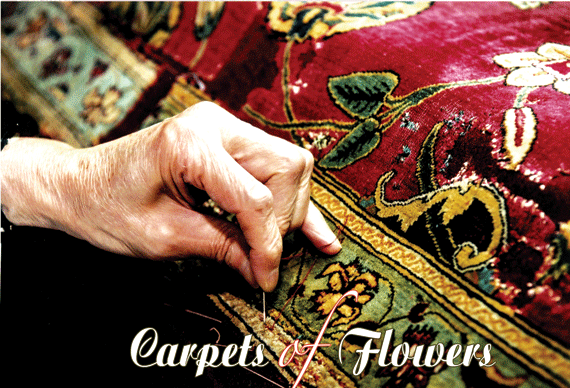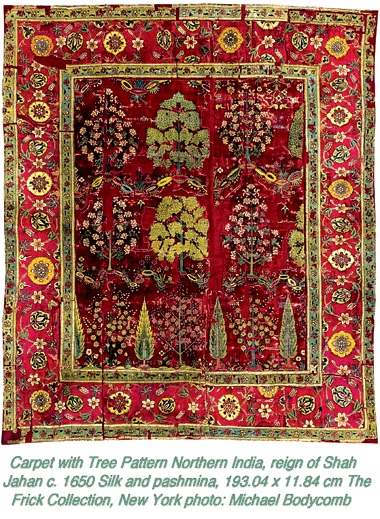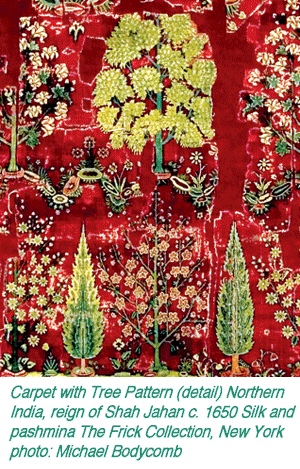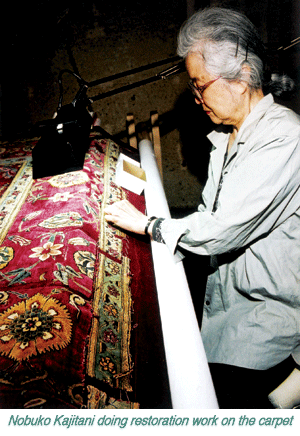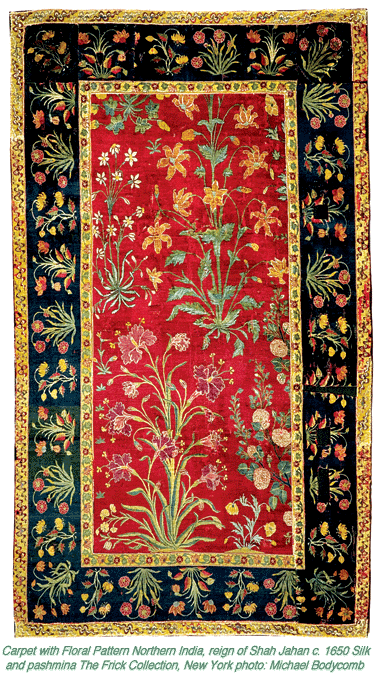|
ARTS & CRAFTS |
|
|
Written by Elisabeth Greenberg
Photographs courtesy of The Frick Collection
![]()
 wo
stunning Mughal carpets, lovingly restored from fragments, are to be
re-exhibited at the Frick Collection in New York this year (2006).
They demonstrate clearly why noted art scholar Daniel Walker, now
the director of The Textile Museum in Washington, DC, titled his
book on Mughal carpets Flowers Underfoot: Indian Carpets of the
Mughal Era. Stately trees rise above stepping-stone paths laced with
delicate groundcover in the centrepiece of one carpet, while an
exuberant display of lilies, roses, poppies, primroses, lotus
flowers, tulips and carnations flourishes in the other.
wo
stunning Mughal carpets, lovingly restored from fragments, are to be
re-exhibited at the Frick Collection in New York this year (2006).
They demonstrate clearly why noted art scholar Daniel Walker, now
the director of The Textile Museum in Washington, DC, titled his
book on Mughal carpets Flowers Underfoot: Indian Carpets of the
Mughal Era. Stately trees rise above stepping-stone paths laced with
delicate groundcover in the centrepiece of one carpet, while an
exuberant display of lilies, roses, poppies, primroses, lotus
flowers, tulips and carnations flourishes in the other.
Another world
Just a glimpse of this craftsmanship takes the viewer into another world of lush and vibrant meadows and gardens. These carpets, displayed in a richly panelled room at the end of a flourishing atrium garden at the Frick Collection, are two of only five hundred Mughal carpets known to the world today. Pieced together from fragments, and divested of their Victorian embellishments by noted conservator Nobuko Kajitani, they now reveal a new freshness and beauty to carpet aficionados.
The Mughal EmpireWith so few Mughal carpets available to study, a glimpse of their history helps one to understand their importance. The Mughal Empire reigned only a short time in Northern India and Pakistan, but it burst onto the world scene with new ideas, an appreciation of art and architecture, and an understanding of how a burgeoning economy could help artists and scholars produce work of the highest quality.
Babur and HumayunIn the early 1500s Babur, or Babar, a descendant of Tamerlane and Genghiz Khan, came into Northern India at the request of the Indian governor there and defeated the Lodi army |
|
at Panipat. Babur ruled until 1530, when his son Humayun came to power. As well as further consolidating the Mughal Empire, Humayun also indulged his interest in art, particularly miniature painting. He spent some time in Persia, at the court of Tahmasp Safavi, and learned much about the Safavid fine arts. When Humayun finally returned to India, he brought with him two noted painters: Abd As-Samad and Mir Sayyid Au. This was how the Mughal school of painting came to develop, combining stylised aspects of Safavid miniature painting with naturalistic depictions of flora in the borders. This style was developed in the carpet ateliers, or studio-workshops, under the guidance of the third Mughal Emperor Akbar.
Akbar
Akbar extended Mughal rule over all Northern India and as far south as the Deccan Plateau. Akbar not only opened and maintained numerous ateliers, for writing, painting, goldsmithing and tapestry and carpet weaving; he also relished the actual activity of designing and crafting, as observed by Antonio Monserrate, a European visitor at the court. The work of the carpet ateliers, carefully documented in the writings of Abul Fazl, Akbar's biographer, had a lasting effect, not only on the carpets of India, but also on the paintings of the Western world where they can be glimpsed in Dutch interiors.
Individual ateliers
According to Walker, Akbar's active support of individual ateliers transformed and defined the essential features of Mughal art. Akbar's artists synthesised many traditions, incorporating design elements from Persia, Europe, and India. The liveliness of traditional Indian art infused the Persian structure with new life and vigour, while the influence of European herbal engravings was responsible for the naturalistic elements.
Shah JahanAlthough carpets had been woven and knotted in India for many centuries, Mughal carpets reached a peak of perfection, being so densely and precisely knotted that they often have a shadow line on each flower for added depth and texture. This is especially evident in the carpets woven during the time of Shah Jahan, Akbar's grandson. Shah Jahan has come to be known as one of the very greatest of the Mughal rulers, building the Taj Mahal, among other architectural gems, and controlling an empire that was at its greatest in the mid-1600s.
Sheikh Safi, ArdabilOf the two rugs now on display in The Frick Collection, the larger and more expensive, with its stylised rows of trees, was probably produced during the first half of the 17th century in the royal factory at Lahore. |
|
Shah Jahan chose the rug as a gift for the tomb mosque of Sheikh Safi (from whom the Safavids came) in Ardabil, Persia. Its decoration, as with the smaller carpet, shows a garden, in the Mughal miniature style. Both rugs were woven on upright looms from the softest wool gathered from the Himalayan mountain goat. This type of material is generally known as cashmere or pashmina in the West.
History
Researchers are currently working on trying to piece together the carpets' history, to accompany their physical restoration. It is thought that restorers in the mid-19th century chose to imitate the original pattern of the rug in embroidery, matching colours and designs, but not the knotting technique. They also added a fringe, perhaps to hold it all together. In 1918 Henry Clay Frick bought the rugs as part of a purchase from the dealer Joseph Duveen of London. Both were intended to furnish his new home in New York City, which now houses The Frick Collection.
Nobuko Kajitani
Nobuko Kajitani came to work on these fragmented Frick carpets following her retirement from the Metropolitan Museum of Art in 2003. When she left the Metropolitan Museum, she had transformed the textile conservation department from a repair and re-weaving shop to a world-class conservation facility, guided and inspired by her technical accuracy and her wide historical and artistic knowledge of carpet and textile knotting and weaving traditions.
Detective-workAt the Frick, through careful detective-work, Kajitani searched out fragments of the larger carpet (some in other museums) in order to discern its basic pattern and to estimate its original size - probably twice that of the contemporary piece. Only then could Kajitani determine how the individual patterns repeated themselves and how the borders should be oriented, establishing, for example, that one border had been reversed. In contrast to her predecessors, Kajitani doesn't choose to restore carpets to their imagined glory; instead, she attempts to take away all new additions to reveal the original design and workmanship. At the same time, she protects the work under conservation for the future. The carpets are now backed with fabric and encased in glass; they will only be moved within their glass frames. |
|
Connecting the fragments
Once Kajitani had clearly in her mind the original concept of the rug, she removed all post-17th century additions. She unstitched each embroidery thread. She took away the added fringe. When she could see the original work, she then backed the missing areas with separate fabric that matched and blended with the background of the rug. She connected the fragments that she could find to make a whole, though much reduced in size. And, of course, she cleaned the fibres so that the original colours shone through.
Changing perspective
For the first time, museum visitors can see and understand the structure of this rug. The trees, particularly the cypresses, make an almost architectural statement of height and growth. The cypresses and the almost triangular pink floral trees, each with a pointed apex, are contrasted with the more rounded shapes of the vividly-blossoming trees between them. Ribbon-like stepping stones guide the eye across the rug just as the tall trees lead the eye upward. The borders share a similar alternation of movement and stasis, although in the border the emphasis is on dynamic movement in contrast to the more controlled centre. The larger flowers, from a perspective which looks down on the flower head, resemble simulated mandalas, interlaced and decorated by a twisting and turning delicately flowered vine.
|
|
Glowing flowersThe smaller rug places the more dynamic vibrant scene in the centre and uses more stylised flowers in the static border. The huge glowing flowers in the centre grow organically. Their leaves bend and twist gracefully, while the flower heads open to the sun or droop romantically to the ground. Bright yellow pistils leap outward on the lilies, while roses appear to spin in place, so carefully are their concentric petals knotted and detailed. One's gaze is led out to the deep groundwork of the borders by the outward leaning of the different centre plants. Here we can imagine the influence of the Agra mosaics, as the stylised plants, viewed from four different directions, leap out from the ground. Each plant is abruptly stopped by the outermost border and drops its tallest flowers back toward the centre. |
From this stylised border the eye jumps and darts and circles back to the gorgeous centre field.
Signature colour
Just as indigo, made from the indigofera plant, was a trademark colour in the Arabian peninsula weavings, the bright red of these carpets was a signature colour of the Mughal farazkhan. The colour called Lac (shellac) comes from the female kerr insect. It lives in trees found in India, Cambodia, Thailand, and Sumatra. Lac was so valued in India that for long periods its exportation was prohibited; its colour being reserved for the Mughals.
